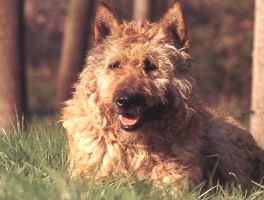BELGIAN SHEPHERD DOG




FCI-Standard No 15/ 19.04.2002 /GB
(Chien de Berger Belge)
TRANSLATION: Mrs. Jeans-Brown, revised by Dr. R. Pollet.
ORIGIN: Belgium.
DATE OF PUBLICATION OF ORIGINAL VALID STANDARD: 22.06.2001.
UTILISATION: Originally a sheep dog, today a working dog (guarding, defence, tracking, etc.) and an all-purpose service dog, as well as a family dog.
CLASSIFICATION F.C.I.: Group 1 Sheepdogs and Cattle Dogs
(except Swiss Cattle dogs).
Section 1 Sheepdogs.
With working trial.
BRIEF HISTORICAL SUMMARY: In Belgium, at the end of the 1800s, there were a great many herding dogs, whose type was varied and whose coats were extremely dissimilar. In order to rationalise this state of affairs, some enthusiastic dog fanciers formed a group and sought guidance from Prof. A. Reul of the Cureghem Veterinary Medical School, whom one must consider to have been the real pioneer and founder of the breed.
The breed was officially born between 1891 and 1897. On September 29th, 1891, the Belgian Shepherd Dog Club (Club du Chien de Berger Belge) was founded in Brussels and in the same year on November 15th in Cureghem, Professor A. Reul organised a gathering of 117 dogs, which allowed him to carry out a return and choose the best specimens. In the following years they began a real programme of selection, carrying out some very close interbreeding involving a few stud dogs.
By April 3rd, 1892, a first detailed breed standard had already been drawn up by the Belgian Shepherd Dog Club. One single breed was allowed, with three coat varieties. However, as was said at the time, the Belgian Shepherd only belonged to ordinary people and therefore the breed still lacked status.
As a result, it wasn’t until 1901 that the first Belgian Shepherds were registered with the Royal Saint-Hubert Society Stud Book (L.O.S.H.).
During the following years, the prime movers among the Belgian Shepherd enthusiasts set to work with great determination to unify the type and correct the faults. It can be said that by 1910 the type and temperament of the Belgian Shepherd had been established.
During the history of the Belgian Shepherd, the question of differing but acceptable varieties and colours had led to many heated discussions. On the other hand, anything involving morphology, temperament and suitability for work has never caused any disagreement.
GENERAL APPEARANCE: The Belgian Shepherd is a mediolineal dog, harmoniously proportioned, combining elegance and power, of medium size, with dry, strong muscle, fitting into a square, rustic, used to the open air life and built to resist the frequent atmospheric variations of the Belgian climate.
Through the harmony of its shape and its high head-carriage, the Belgian Shepherd should give the impression of that elegant strength which has become the heritage of the selected representatives of a working breed. The Belgian Shepherd is to be judged in its natural stance, without physical contact with the handler.
IMPORTANT PROPORTIONS: The Belgian Shepherd dog can be fitted into a square. The chest is let down to the level of the elbows. The length of the muzzle is equal to or slightly longer than half the length of the head.
BEHAVIOUR / TEMPERAMENT: The Belgian Shepherd is a watchful and active dog, bursting with energy, and always ready to leap into action. As well as its innate skill at guarding flocks, it also possesses the highly prized qualities of the best guard dog of property. Without any hesitation it is the stubborn and keen protector of its owner. It brings together all those qualities necessary for a shepherd, guard, defence and service dog.
Its lively, alert temperament and its confident nature, showing no fear or aggressiveness, should be obvious in its body stance and the proud attentive expression in its sparkling eyes.
When judging this breed, one should take into consideration its calm and fearless temperament.
HEAD: Carried high, long without exaggeration, rectilinear, well chiselled and dry. Skull and muzzle are roughly equal in length, with at the most a very slight bias in favour of the muzzle which puts the finishing touch to the whole head.
CRANIAL REGION: Of medium width, in proportion with the length of the head, with a forehead flat rather than round, frontal groove not very pronounced; in profile, parallel to imaginary line extending muzzle line; occipital crest little developed; brow ridges and zygomatic arches not prominent.
Stop: Moderate.
FACIAL REGION:
Nose: Black.
Muzzle: Medium length and well chiselled under the eyes; narrowing gradually toward the nose, like an elongated wedge; bridge of the nose straight and parallel to the continuation of the topline of the forehead; mouth well split, which means that when the mouth is open the commissures of the lips are pulled right back, the jaws being well apart.
Lips: Thin, tight and strongly pigmented.
Jaws/teeth: Strong, white teeth, regularly and strongly set in well-developed jaws. Scissor bite; pincer bite, which is preferred by sheep and livestock herders, is tolerated. Complete dentition according to the dental formula; the absence of two premolars 1 (2 P1) is tolerated and the molars 3 (M3) are not taken into consideration.
Cheeks: dry and quite flat, although muscled.
Eyes: Medium size, neither protruding nor sunken, slightly almond-shaped, obliquely set, brownish colour, preferably dark; black rimmed eyelids; direct, lively, intelligent and enquiring look.
Ears: Rather small, set high, distinctly triangular appearance, well-rounded outer ear, pointed tips, stiff, carried upright and vertical when dog is alert.
NECK: Well standing out, slightly elongated, rather upright, well-muscled, broadening gradually towards the shoulders, without dewlap, nape slightly arched.
BODY: Powerful without being heavy; length from point of shoulder to point of buttock approximately equal to height at withers.
Topline: upper line of back and loins is straight.
Withers: Pronounced.
Back: firm, short and well-muscled.
Loins: Solid, short, sufficiently broad, well-muscled.
Croup: well-muscled ; only very slightly sloping ; sufficiently broad but not excessively so.
Chest: little broad, but well let down; upper part of ribs arched; seen from the front forechest little broad, but without being narrow.
Underline: Begins below the chest and rises gently in a harmonious curve towards the belly, which is neither drooping nor tucked up, but slightly raised and moderately developed.
TAIL: Well set on, strong at the base, of medium length, reaching at least to hock, but preferably further; at rest carried down, with tip curved backwards at level of hock; more raised when moving, although without passing the horizontal, the curve towards the tip becoming more accentuated, without ever at any time forming a hook or deviation.
LIMBS
FOREQUARTERS:
General view: Bone solid but not heavy; muscle dry and strong; front legs upright from all sides and perfectly parallel when seen from the front.
Shoulder: Shoulder blade long and oblique, well attached, forming a sufficient angle with the humerus, ideally measuring 110-115 degrees.
Upper arm: Long and sufficiently oblique.
Elbow: Firm, neither turning out nor tied in.
Forearm: Long and straight.
Wrist (carpus): very firm and clean.
Front pastern (metacarpus): Strong and short, as perpendicular to the ground as possible or only very slightly sloping forward.
Feet: Round, cat feet; toes arched and well closed; pads thick and springy; nails dark and strong.
HINDQUARTERS:
General view: Powerful, but not heavy; in profile hindlegs are upright and seen from GO BACK TO LIST perfectly parallel.
Upper thigh: Medium length, broad and strongly muscled.
Stifle: approximately on the plumb line from the hip; normal stifle angulation.
Lower thigh: Medium length, broad and muscled.
Hock: Close to the ground, broad and muscled, moderate angulation.
Back pastern (metatarsus): Solid and short; dewclaws not desirable.
Feet: may be light oval; toes arched and well closed; pads thick and springy; nails dark and strong.
SUGGESTED BREEDINGS by MENANDPETS.COM:
No breeding to signal
if you want to know like signaling yours, contacts: marketing@inseparabile.it
GAIT / MOVEMENT: Lively and free movement at all gaits; the Belgian Shepherd is a good galloper but its normal gaits are the walk and especially the trot; limbs move parallel to the median plane of the body. At high speed the feet come nearer to the median plane; at the trot the reach is
medium, the movement even and easy, with good rear drive, and the topline remains tight while the front legs are not lifted too high. Always on the move, the Belgian Shepherd seems tireless; its gait is fast, springy and lively. It is capable of suddenly changing direction at full speed. Due to its exuberant character and its desire to guard and protect, it has a definite tendency to move in circles.
SKIN: Elastic but taut over all the body; edges of lips and eyelids strongly pigmented.
COATS AND VARIETIES: Since the coat varies in length, direction, appearance and colour among Belgian Shepherds, this particular point has been adopted as the criterion for distinguishing between the four varieties of the breed: the Groenendael, the Tervueren, the Malinois and the Laekenois.
These four varieties are judged separately and can each be awarded a C.A.C., a C.A.C.A.B. or a reserve title.
HAIR: In all the varieties the hair must always be dense, close-fitting and of good texture, with the woolly undercoat forming an excellent protective covering.
- LONG HAIR: The hair is short on the head, the outer side of the ears and the lower part of the legs, except on the rear side of the forearm which is covered from elbow to wrist by long hairs called fringes. The hair is long and smooth on the rest of the body and longer and more abundant around the neck and on the forechest, where it forms a collarette or ruff and a jabot or apron. The opening of the air is protected by thick tufts of hair. From the base of the ear the hair is upright and frames the head. The back of the thighs is covered with very long abundant hair forming the culottes or breeches. The tail is furnished with long, abundant hair forming a plume.
The Groenendael and the Tervueren are the long-haired.
- SHORT HAIR: The hair is very short on the head, the outer sides of the ears and the lower part of the legs. It is short over the rest of the body and fuller at the tail and around the neck where it forms a collarette or ruff which begins at the base of the ear, stretching as far as the throat. As well, the back of the thighs is fringed with longer hair. The tail is ear of corn shaped, but does not form a plume.
The Malinois is the short-haired.
- ROUGH HAIR: What especially characterises the rough hair variety is the roughness and dryness of the hair, which, moreover, is rasping and tousled. About 6 cm long over the whole body, the hair is shorter on the top of the muzzle, the forehead and the legs. The hair around the eyes and those furnishing the muzzle should not be so long as to disguise the shape of the head. However, it is essential to have furnishings on the muzzle. The tail should not form a plume.
The Laekenois is the rough-haired.
COLOUR:
Mask: For Tervueren and Malinois the mask must be very pronounced and tend to encompass the top and bottom lip, the corners of the lips and the eyelids in one single black zone. A strict minimum of six points of skin pigmentation is called for: the two ears, the two upper eyelids and the two lips, upper and lower, which must be black.
Black overlay: In Tervueren and Malinois, the black overlay means that the hairs have a black tip which shades the base colour. This blackening is in any case “flamed” and must not be present in great patches nor in real stripes (brindled). In the Laekenois the black shading is more discreetly expressed.
Groenendael: Only uniform black.
Tervueren: Only fawn with black overlay or grey with black overlay, with black mask; however, the fawn with black overlay is still preferred. The fawn must be rich, neither light nor washed-out. Any dog whose coat colour is anything but fawn with black overlay or does not match the desired intensity of colour cannot be considered an elite specimen.
Malinois: Only fawn with black overlay and with black mask.
Laekenois: Only fawn with traces of black overlay, mainly on the muzzle and the tail.
For all varieties: a small amount of white is tolerated on forechest and toes.
SIZE, WEIGHT AND MEASUREMENTS:
Height at withers:
The ideal weight at withers is on average - 62 cm for males
- 58 cm for females.
Limits: 2 cm less, 4 cm more.
Weight:
Males about 25-30 kg.
Females about 20-25 kg.
Measurements: Average normal measures for an adult male Belgian Shepherd of 62 cm at the withers:
- Length of body (from point of shoulder to point of buttock): 62 cm.
- Length of head: 25 cm.
- Length of muzzle: 12,5 – 13 cm.
FAULTS: Any departure from the foregoing points should be considered a fault and the seriousness with which the fault should be regarded should be in exact proportion to its degree.
- General appearance: Cloddy, lacking elegance; too light or too slender; longer than high; fitting into a rectangle.
- Head: heavy, too strong, lacking parallelism, not sufficiently chiselled or dry; forehead too rounded; stop too accentuated or too flat; muzzle too short or pinched; Roman nose; brow ridges or zygomatic arches too prominent.
- Nose, lips and eyelids: traces of depigmentation.
- Dentition: badly aligned incisors. Serious fault: lack of one incisor (1 I), one premolar 2 (1 P2), one premolar 3 (1 P3) or three premolars 1 (3 P1).
- Eyes: light, round.
- Ears: large, long, too broad at the base, set low, carried outward or inward.
- Neck: slender; short or deep set.
- Body: too long; thoracic cage too broad (cylindrical).
- Withers: flat, low.
- Topline: back and/or loins long, weak, sagging or arched.
- Croup: too sloping, overbuilt.
- Underline: too much or too little let down; too much belly.
- Tail: set too low; carried too high, forming a hook, deviated.
- Limbs: bone too light or too heavy; bad upright stance in profile (e.g. front pasterns too sloping or weak wrists), from the front (feet turning in or out, out at elbow, etc.), or from GO BACK TO LIST (hindlegs too close, too wide apart or barrel shaped, hocks close or open, etc.); too little or exaggeratedly angulated.
- Feet: spreading.
- Gait: moving close, too short a stride, too little drive, poor back transmission, high stepping action.
- Coat: all four varieties: insufficient undercoat.
Groenendael and Tervueren: woolly, wavy, curly hair; hair not long enough.
Malinois: hair half-long where it should be short; smooth-haired; harsh hairs scattered in the short coat; wavy coat.
Laekenois: hair too long, silky, wavy, crisp-haired or short; filled with fine hairs scattered in tufts in the rough hair; hairs too long around the eye or the lower end of the head (the chin); bushy tail.
- Colour: for all four varieties: white marking on chest forming tie; white on the feet going beyond toes.
Groenendael: reddish tinges in the coat; grey breeches.
Tervueren: grey.
Tervuren and Malinois: brindle; tints not warm enough; not enough or too much black overlay or set in patches over the body; not enough mask.
Tervueren, Malinois and Laekenois: too light a fawn; a base
colour which is very diluted, named washed-out, is considered a serious fault.
- Temperament: specimens lacking in self-confidence or overly nervous.
DISQUALIFYING FAULTS:
- Temperament: aggressive or timid specimens.
- General appearance: lack of breed type.
- Dentition: overshot; undershot, even if contact is not lost (reverse scissor bite); crossbite; absence of one canine (1 C), one upper carnassial (1 P4) or lower carnassial (1 M1), one molar (1 M1 -upper jaw- or 1 M2; M3 are not taken into account), one premolar 3 (1 P3) plus one other tooth or a total of three teeth (excluding the premolars 1) or more.
- Nose, lips, eyelids: strong depigmentation.
- Ears: drooping or artificially kept erect.
- Tail: missing or shortened, at birth or by docking; carried too high and ringed or curled.
- Coat: lack of undercoat.
- Colour: any colours which do not correspond with those of the described varieties; too widespread white markings on forechest, especially if they reach as far as the neck; white on feet going more than halfway up the front or the back pasterns and forming socks; white markings anywhere other than forechest and toes; lack of mask, including a muzzle of lighter colour than the rest of the coat in Tervueren and Malinois.
- Size: outside the limits laid down.
N.B.: Male animals should have two apparently normal testicles fully descended into the scrotum.
CROSSBREEDING – MATINGS BETWEEN VARIETIES:
Any matings between varieties are forbidden, except in exceptional circumstances, when this ban can be lifted by the appropriate and official breed councils (Text 1974, drawn up in Paris).
BELGIAN SHEPHERD DOG (Chien de Berger Belge)
Automatic translate from inseparabile.com
Introduction
During 1800, the European shepherds have perfected several breeds of dogs in order to assemble, to guide and protect their crudes oil.
The Germany has created the shepherdesses German; France Briard and the Beauceron; The Portugal ancient Castro Laboreiro; Hungary the Puli; The Polonia the Tatra and l Owczarek Nizinny; and Belgium of fiandre and the four types of shepherds exactly SHEPHERDS BELGIAN.
The four Belgian are develop you for the same ones use of base. But they have been distinguished, four types that are the Groenenlander the Malinois, the Tervuren; and the Lakenois.
Initially, the breeders have produced the same ones
cucciolate dogs of the different cape allinterno of the same ones later on begun to distinguish the four breeds. Three types have taken the names from the zone in which they are develops to you. Cos the section of the Parc du Laekenof Brussels has created the Laekenois, the region of Malines has given the name to the Malinois; and the citt of Tervueren it has perfected the Tervuren. The Groenendael has obtained the relative name from Chateau Groenendael, a restaurant possessed from the selezionatore Nicolas Rose.
The dogs of Belgium are perfect as dogs from family
The three dogs from shepherdesses Belgian are themselves adapt much good to you to their new role of dogs from guard and defense from when the pastorizia gone in crisis.
Today they serve like dogs policeman, dogs from rescue and search, guardiani and dogs from guide for blind people and eccellono in in the agilit, the obedience, the flyball.
Like the greater part of the others breeds from guard, the Belgian can be suspicious in the comparisons of disowned and the situations not known and aggressive with the small the animals, comprised the cats. For this they need of one good socialization from puppys.
Like List of dog breeds highly intelligent, they have moreover need of a constant training and continuous stimuli.
Laddestramento does not go executed with violent methods and hard punishments otherwise the dog pu to become dangerous.
Characteristics
The characteristics of the race for the four are virtually identical except the type and the color of the cape. The dogs are very balance to you, elegant, strong, attention, agile and muscolosi. The imposing male devout of the female.
Even if they have a superficial rassomiglianza with the shepherdesses German, the dogs Belgian are squares, not rectangular, once it observes to you from the side.
Temperament these dogs they would have to be sure, reserves you with the disowned ones and naturally protect to you in the comparisons of the family and theirs propriet. They are not never aggressive without reason and they are much trainable.
The eyes would have to show the vigilance, the confidence and intelligence.
it points out to the standard
CLASSIFICATION: Group 1: dogs from shepherdesses and bovari (excluded the Swisses).
AVERAGE LIFE: 10-14 years.
MATURE ETA': 18-24 months.
HEAD: To shape of wedge, long without esagerazione, snout with straight nasal cane, stop moderated.
ORECCHIE: Attacked high, triangular, erected and rigid.
EYES: Of medium largeness, to almond and dark.
LOG: Powerful but not heavy, constructed in the square. Wide and muscoloso back, wide and deep thorax.
LIMBS: Well in perpendicularly, dry grounds and muscolosi, angled so as to toconcur a lively and melted sailing point.
TAIL: Of medium, hanging length if R-retired, capacity to half air if the dog to the job.
GENERAL ASPECT: Sturdy, elegant and harmonic, with portamento I alter of the head. The ransom of 62 cm to the garrese for the male and of 58 cm for the female, with one tolerance of 2 cm in less and than 4 in devout. The weight is gone around around to the 30 kg.
Malinois
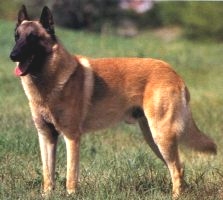
Variet to short hair fulvo carbonate. In practical a "Belgian without the fur", identical in the physicist to the others variet. E' called cos perch been born in the outskirtses of the citt of Malines. Less diffused of the variet to long hair, perch considered "too much similar to the shepherdesses German", in realt the portamento and the nature they are spiccatamente Belgian. Optimal for the personal defense, in how much its bite turns out devout the effective one of the four variet, used also like policeman, in how much "it thinks little and it obeys in a hurry devout of the other Belgian". Just these its qualit characterial have increased some of recent the spread, than before it was much inferior to the cousinses for exclusively aesthetic reasons.
Groenendael
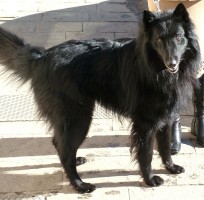
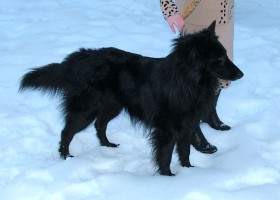
the magnificent copy of the photo of propriet of Luciano Rela and Daniela Cogo
Shepherdesses Belgian to long, smooth and black hair on all the body, with to times one zone white woman on the chest.
The first subjects of this type were select to you after the 1890 from Nicole Ros. In the 1898 they also earned the income in the book of the origins of the breeds. The progenitore selected from Ros came called Duc de Groenendael, from the name of its castle. From the name of the variet comes down here therefore. E' the diffuse Belgian devout, to cause perhaps of the long and lucente hair, from the characteristic black color corvino, than it differentiates from all the other dogs shepherds of tonnage and similar aspect. Eccelle in the conduction of the crudes oil thanks to its detached attitude to work with the man, and also in the job and obedience contests. E' a lot used also from the attache's to the civil protection as dog from tries in the ruins, while less in the police, perch it does not have same metodicit of the shepherdesses German (the inarrivabile policeman). Thanks to its agile physicist and releasing d satisfactions also in the agility dog.
Belgian Tervuren
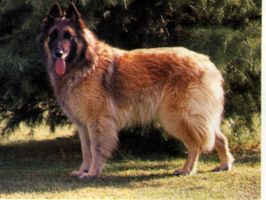
Variet to long hair fulvo carbonate. Of all the similar one to the cousins groenendael for webbing of the hair, it differs alone in the color. The black prototype the same one of the Belgian, single that gives that cucciolata was chosen those fulvi, than they were initially not recognized like pure race. Terveuren the name of one localit in the periphery of Brussels. E' always be considered the cousinses poor of the Groenendael, but from a decade to this part its acquires is in increase, from the moment that draft of a beautifulst dog that deserved this happening for a long time. Curious much sensitive one to the feminine voice, tant' that it learns better if trained from one woman! Bond also for the personal defense and the agility, pu not to compete in the conduction of the flock with the black cousins, incontrastato leader in the specialit.
Laekenois
If the dogs Belgian were arranged parallel, little would connect the Laekenois with its cousinses. Its hard, tangled hair, moderately along characterizes the cape on the head and the snout, dandogli one rassomiglianza to the bovaro of the fioandre
The Laekenois semprefulvo with traces of black, especially on the snout and the tail.
| You want to help us: you insert one of ours banner on your pages |
copyright
INSEPARABLE 18/12/2000 2000-2012 |
QUICK LINK
© menandpets All rights reserved.
|
